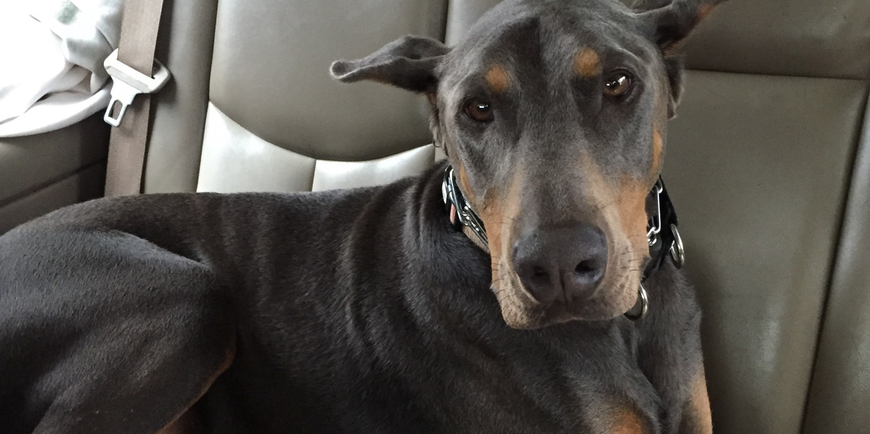
When it comes to dog training, figuring out a solid training approach can be an overwhelming task for many dog owners. With so much conflicting information on the web, dog owners are often times left confused and unsure who to believe.
In my opinion, much of what is said on the Internet about dog training is misinformation, and is often times based on lack of willingness to understand certain training tools and philosophies. So what I’ve done, here, is put together a list of what I firmly believe are the essentials to having a well behaved dog, without going into details about training techniques and tools. I hope you find these 10 commandments of dog training informative!
1.) Stay Consistent – This is perhaps the most important one of them all, and anyone who is knowledgeable in the field of dog training will agree. If you want to see any kind of long-term change in your dog’s behavior, consistency is the only thing that will get you there.
Just like humans, dogs know when they can push boundaries and get away with things. And trust me, they will! Also, just just like humans, dogs require time and continual exposure to learn knew skills and habits. So if you forget all other things you read on this post, at least remember this one thing!
2.) No Spoiling or Humanizing Your Dog – Unless you have one of the few piece-of-cake dogs that has no behavioral issues, doing these things will surely cause problems one way or another. Giving your dog too much affection and treating him like a human is prime way give your dog the impression that you are not a significant leader. Dogs are very smart animals, and they will pick up on all of the little things that we do. And by spoiling and humanizing, most dogs will take advantage of our soft nature.
We certainly can give or dogs affection and praise, be we must also be there to give our dogs clear rules and boundaries. Like kids, dogs that are spoiled and pampered will often times display “bratty-like” behaviors that drive us crazy.
3.) Never Accidentally Reinforce Anxiety, Fear, Nervousness, or Aggression – As humans, it is in our nature to help comfort and sooth those in need or discomfort. However, when it comes to dogs, comforting and soothing during times like these will only reinforce their negative states of mind.
Unlike humans, dogs don’t know our intentions are to help ease their discomfort by comforting and pampering them. Instead, they think we are REWARDING them for being anxious, fearful, nervous, or aggressive, which gives them the impression that they are doing the right thing. Instead, always ignore these states of mind and remain neutral. To a dog, this is one of the most comforting things we can do.
4.) Choose a Dog that Matches Your Physical Activity and Personality – One common mistake many dog owners make is choosing a dog that is not fit for their lifestyles. If you are a physically active person who likes to get outdoors often, then a high energy dog such as a boarder collie, Australian shepherd, or German Shepherd may be best for you. However, if you are a person who relaxes often and is not very active, one of these kind of dogs may not be a best fit for you.
Aside from your daily physical daily activity, another important thing to keep in mind is your personality. Do you have a soft personality that struggles with being firm at times? If so, then getting a dog that is more laid back and more compliant would best for your. But if your personality is more firm, and you are not afraid to set rules and boundaries, then it would be okay for you to have a more challenging and willful dog.
When the personalities of both human and dog are at conflict, the problems are much more likely to develop.
5.) Correct Unwanted Behaviors – No unwanted behavior will go away without addressing it. And by not correcting unwanted behaviors, you are actually giving the dog the message the what he is doing is okay. Just like a child who continues to misbehave due to a lack of consequences, so also will dogs continue to misbehaved without consequences. So please consider these wise words right here: If you don’t correct it, you reinforce it.
6.) Reward Good Behaviors (Without Overdoing It) – Now that we’ve discussed correcting bad behaviors, it follows that rewarding good behaviors is necessary. Dogs (and people!) love to rewarding or simply even recognized for doing something right. By rewarding our dogs for doing what we want them to do, we help to cultivate new habits in our dogs.
But be aware!…You don’t want to overdo rewarding and praising. Overdoing things can often times cause dogs to become overexcited, which gets dogs more distracted and more likely to make mistakes. Not only that, but you want to save your bigger praising and rewarding for accomplishments that are much more significant. Really make sure your dog EARNS your praise!
7.) Never Correct Your Dog With Anger or Emotional Intensity – While giving a dog a correction is needed at times, it’s important to realize that we need to remain calm when giving corrections. Never get angry or start yelling. While sometimes it can be beneficial to speak in a more firm tone, it is often times best to remain neutral during a correction.
By becoming angry with our dogs when they make mistakes, one of two things will often times happen. One is that the dog could start to lose trust due to your negative energy (if the dog has a softer temperament). The other way dogs often times respond to our frustration (I see this a lot!) is by not taking us seriously.
Often times it can even amp up the dogs attitude, making the behavior worse. For many dogs, our frustration and negative energy can actually be rewarding to them. It shows them that we don’t really have control, and that our frustration is a product of our lack of ability to follow through with leadership. Dogs feed on this stuff all of the time!
8.) Keep Your Expectation Realistic – Dogs are dogs, and humans are humans. Neither are perfect. Therefore, we should have reasonable expectations for how far we want our dogs to come. While dogs can certainly make huge strides in their overall behavior, all dogs have a limits.
If you have a dog with some serious issues, you can expect that your dog just might have some more limitations and than a dog with more mild issues. And if you have an extremely high energy and adrenaline, there’s a good chance your dog will have more limitations that a dog that is naturally calm and lower energy.
But even though our dogs and ourselves can never be perfect, this doesn’t mean we cannot strive to achieve great strides with our dogs. All that I am saying is that we don’t have unreasonable expectations when it comes to our dogs.
9.) Don’t Give Your Dog Too Much Freedom – Many owners many the mistake of giving their dogs too much freedom too quickly. Too much freedom is often times the source of many behavioral issues. When dogs aren’t given rules or boundaries by their owners, they tend to think of their owners as an insignificant authority figures. (just like kids do!) Just like in the human world. dogs should be given freedom incrementally, and it should be something that is earned.
10.) Don’t Dwell on the Past – One of the biggest misconceptions in the dog world is the idea that dog’s with bad pasts need constant comfort and affection. Perhaps this may sound cold and heartless, but the last thing a dog like this needs is constant attention. This ties in with the 3rd command that I discussed earlier. Constant attention and affection will often times lead to reinforcing negative state of minds like nervousness and anxiety.
What dogs need more than anything, including dogs that have bad pasts, is structure and guidance. Giving your dog the proper leadership he needs is the best way to help your dog feel confident and secure. If we hang on to our dogs’ past, so will they. If you want your dog to move on, you must move on, as well.
